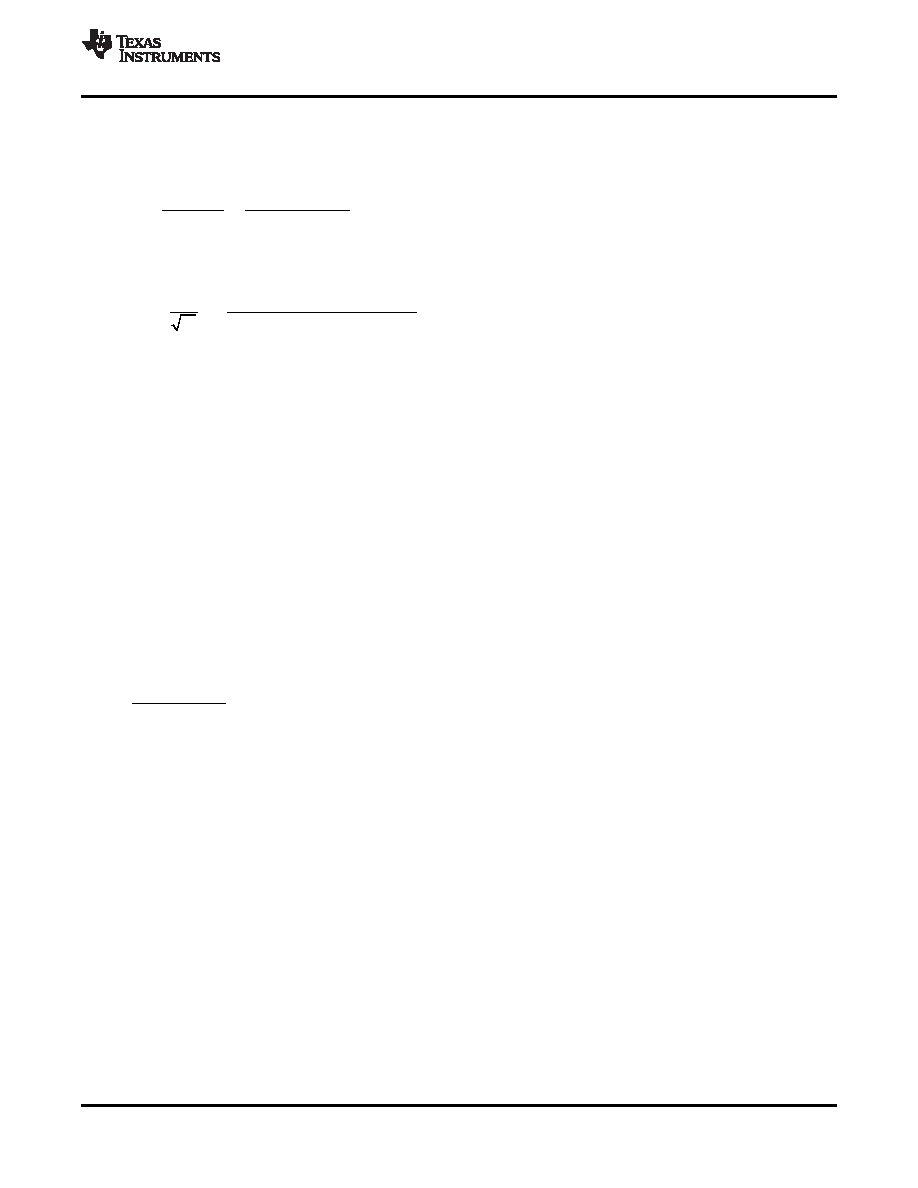- 您現在的位置:買賣IC網 > PDF目錄98283 > TPS54331DG4 (TEXAS INSTRUMENTS INC) 2 A SWITCHING REGULATOR, 684 kHz SWITCHING FREQ-MAX, PDSO8 PDF資料下載
參數資料
| 型號: | TPS54331DG4 |
| 廠商: | TEXAS INSTRUMENTS INC |
| 元件分類: | 穩(wěn)壓器 |
| 英文描述: | 2 A SWITCHING REGULATOR, 684 kHz SWITCHING FREQ-MAX, PDSO8 |
| 封裝: | GREEN, PLASTIC, MS-012AA, SOIC-8 |
| 文件頁數: | 5/27頁 |
| 文件大小: | 794K |
| 代理商: | TPS54331DG4 |
第1頁第2頁第3頁第4頁當前第5頁第6頁第7頁第8頁第9頁第10頁第11頁第12頁第13頁第14頁第15頁第16頁第17頁第18頁第19頁第20頁第21頁第22頁第23頁第24頁第25頁第26頁第27頁

(
)
OPPMAX
max
LPP
SW
O
D
0.5
V
ESR
=
I
4
F
C
-
(
)
12
OUT
IN(MAX)
OUT
COUT(RMS)
IN(MAX)
OUT
SW
C
V
× V
V
1
I
=
×
V
× L
× F
× N
-
÷
÷
è
ggm
REF
DC
O
V
G
=
V
(
)
PO
OO
Z
V
= 1/ 2
R
C
p
(
)
Z1
Z
F
= 1/ 2
R
C
p
(
)
P1
Z
P
F
= 1/ 2
R
C
p
www.ti.com
SLVS839C – JULY 2008 – REVISED MARCH 2010
The maximum ESR of the output capacitor can be determined from the amount of allowable output ripple as
specified in the initial design parameters. The contribution to the output ripple voltage due to ESR is the inductor
ripple current times the ESR of the output filter, so the maximum specified ESR as listed in the capacitor data
sheet is given by Equation 13
(13)
Where VOPPMAX is the desired maximum peak-to-peak output ripple. The maximum RMS ripple current in the
output capacitor is given by Equation 14.
(14)
For this design example, two 47-mF ceramic output capacitors are chosen for C8 and C9. These are TDK
C3216X5R0J476MT, rated at 6.3 V with a maximum ESR of 2 m
and a ripple current rating in excess of 3 A.
The calculated total RMS ripple current is 161 mA ( 80.6 mA each) and the maximum total ESR required is 43
m
. These output capacitors exceed the requirements by a wide margin and will result in a reliable,
high-performance design. it is important to note that the actual capacitance in circuit may be less than the
catalog value when the output is operating at the desired output of 3.3 V The selected output capacitor must be
rated for a voltage greater than the desired output voltage plus the ripple voltage. Any derating amount must
also be included. Other capacitor types work well with the TPS54331, depending on the needs of the application.
COMPENSATION COMPONENTS
The external compensation used with the TPS54331 allows for a wide range of output filter configurations. A
large range of capacitor values and types of dielectric are supported. The design example uses ceramic X5R
dielectric output capacitors, but other types are supported.
A Type II compensation scheme is recommended for the TPS54331. The compensation components are chosen
to set the desired closed loop cross over frequency and phase margin for output filter components. The type II
compensation has the following characteristics; a dc gain component, a low frequency pole, and a mid frequency
zero / pole pair.
The dc gain is determined by Equation 15:
(15)
Where:
Vggm = 800
VREF = 0.8 V
The low-frequency pole is determined by Equation 16:
(16)
The mid-frequency zero is determined by Equation 17:
(17)
And, the mid-frequency pole is given by Equation 18:
(18)
The first step is to choose the closed loop crossover frequency. In general, the closed-loop crossover frequency
should be less than 1/8 of the minimum operating frequency, but for the TPS54331it is recommended that the
maximum closed loop crossover frequency be not greater than 25 kHz. Next, the required gain and phase boost
of the crossover network needs to be calculated. By definition, the gain of the compensation network must be the
inverse of the gain of the modulator and output filter. For this design example, where the ESR zero is much
higher than the closed loop crossover frequency, the gain of the modulator and output filter can be approximated
by Equation 19:
Copyright 2008–2010, Texas Instruments Incorporated
13
Product Folder Link(s): TPS54331
相關PDF資料 |
PDF描述 |
|---|---|
| TPS54350MPWPREP | 7.2 A SWITCHING REGULATOR, 700 kHz SWITCHING FREQ-MAX, PDSO16 |
| TPS54372PWP | 3 A SWITCHING REGULATOR, 762 kHz SWITCHING FREQ-MAX, PDSO20 |
| TPS54418RTER | 6.4 A SWITCHING REGULATOR, 2000 kHz SWITCHING FREQ-MAX, PQCC16 |
| TPS54426PWP | 7.5 A SWITCHING REGULATOR, 700 kHz SWITCHING FREQ-MAX, PDSO14 |
| TPS54429PWP | 0.01 A SWITCHING REGULATOR, 700 kHz SWITCHING FREQ-MAX, PDSO14 |
相關代理商/技術參數 |
參數描述 |
|---|---|
| TPS54331DR | 功能描述:直流/直流開關轉換器 3A 28V In Step Down SWIFT DC/DC Cnvrtr RoHS:否 制造商:STMicroelectronics 最大輸入電壓:4.5 V 開關頻率:1.5 MHz 輸出電壓:4.6 V 輸出電流:250 mA 輸出端數量:2 最大工作溫度:+ 85 C 安裝風格:SMD/SMT |
| TPS54331DRG4 | 功能描述:直流/直流開關轉換器 26V,3A DC-DC Converter RoHS:否 制造商:STMicroelectronics 最大輸入電壓:4.5 V 開關頻率:1.5 MHz 輸出電壓:4.6 V 輸出電流:250 mA 輸出端數量:2 最大工作溫度:+ 85 C 安裝風格:SMD/SMT |
| TPS54331DR-P | 制造商:Rochester Electronics LLC 功能描述: 制造商:Texas Instruments 功能描述: |
| TPS54331EVM-232 | 功能描述:電源管理IC開發(fā)工具 SWIFT Cnvrtr Eval Mod RoHS:否 制造商:Maxim Integrated 產品:Evaluation Kits 類型:Battery Management 工具用于評估:MAX17710GB 輸入電壓: 輸出電壓:1.8 V |
| TPS54331EVM-232 | 制造商:Texas Instruments 功能描述:DEVELOPMENT TOOL |
發(fā)布緊急采購,3分鐘左右您將得到回復。